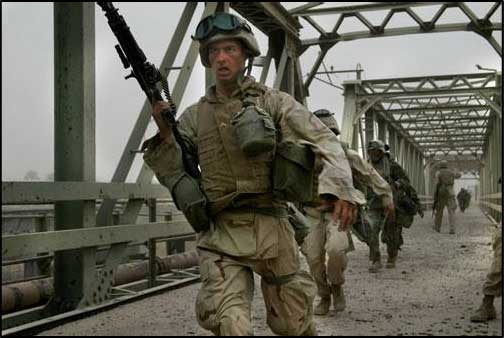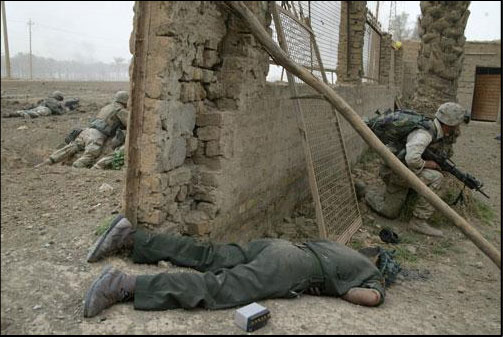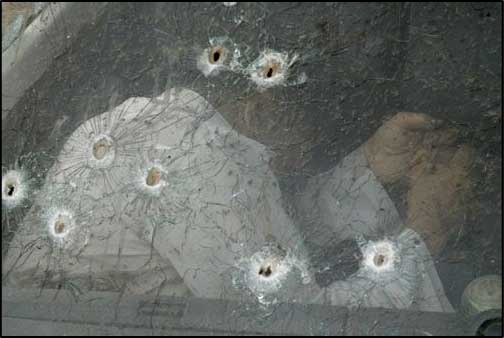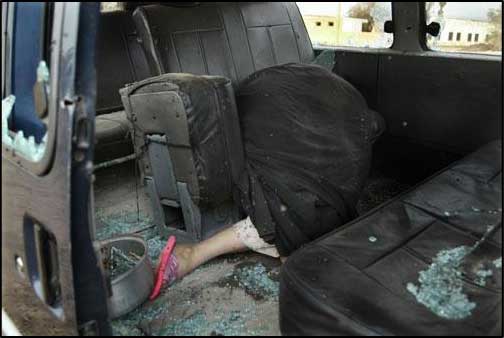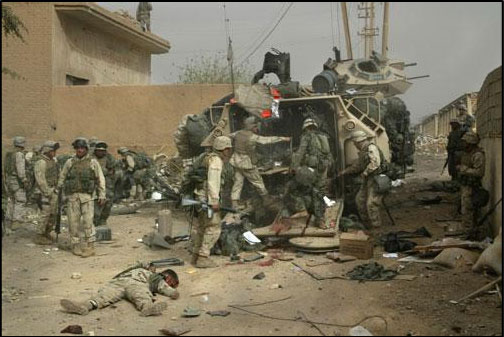


| September 14, 2003 | ||||||
|
What is already evident, though, is that the war was in many ways representative of the changing nature of conflict in today’s world. In the justifications offered for launching the war, the nature and form of the fighting itself, and the problems raised in its aftermath, the conflict in Iraq displayed in concentrated form many of the trends that have been visible in the evolution of armed conflict in recent years. It therefore offers a snapshot of how well international law as it stands is able to govern the conduct of war today. The legal justification offered by government lawyers for the war (as opposed to the rhetoric used to win political support for it) was actually quite narrow. The U.S. and British governments said that previous United Nations resolutions on Iraq offered enough authority for the war, given Saddam Hussein’s refusal to comply with his obligations (see this earlier article for an analysis of these claims). In that sense, the failure to find weapons of mass destruction in Iraq since the end of the conflict does not greatly affect the basic judgement about whether it was launched in breach of, or in accordance with, the U.N. Charter. People who disagree with the legal case made for the war believe that the attack would still have been unlawful, even if some chemical or biological weapons had turned up. For those who argue that Iraq’s refusal to comply with U.N. resolutions gave enough justification for the use of force, it was Saddam’s stonewalling, not the supposed existence of the weapons themselves, that technically made the conflict lawful. However, there is no doubt that the political and moral force of the case for war was based on the idea that Saddam Hussein posed an urgent and growing threat, because of his pursuit of unconventional weapons that might be passed into the hands of terrorists. This argument looks much weaker since the invasion of Iraq. The occupying forces have found no apparent evidence either of an active chemical or biological weapons programme, or of collaboration with al-Qaeda or other related terrorist groups. (Indeed, it seems plausible to argue that the situation in Iraq post-war is much more conducive to the flourishing of terrorism than it was before the conflict.) If an extensive weapons programme had been uncovered in Iraq, the war might have looked in retrospect like a legitimate act of self-defense. It would have acquired a kind of retrospective justification – in the same way that some people claim that Israel’s 1981 attack on the Iraqi nuclear reactor at Osirak has come to seem far-sighted in light of Saddam Hussein’s subsequent behaviour. Conversely, the case for war looks much weaker now that the argument that Saddam posed an immediate threat has been discredited. The occupation of Iraq has confirmed, however, that reports about the cruelty and oppressiveness of Saddam’s regime were entirely accurate, or even understated. As British Prime Minister Tony Blair was always careful to say, Saddam’s repression did not provide a legal basis for invasion, but did provide moral support for the war, by suggesting that the people of Iraq would benefit from his removal. In the past decade, there has been growing support for the notion that humanitarian intervention can be justified where crimes against humanity are taking place and might be stopped. This would probably not have applied in Iraq, though, since it is clear that the worst crimes of the regime (such as the genocidal Anfal campaign against the Kurds) lay in the past. It would be hard to argue that intervention was justified to prevent crimes against humanity that were occurring at the present time. Nevertheless, one effect of the war in Iraq has been to promote debate about whether the international system could be changed to make it easier to stop regimes that are carrying out massive crimes against their own people.
War Against a Regime The Iraq war was significant not only for international law on the resort to force (jus ad bellum), but just as much for the laws governing conduct in war (jus in bello). The first and most fundamental point about the way the war was conducted is that it was – as with the recent U.S.-led actions in Kosovo and Afghanistan – fought against a regime rather than an enemy state. Saddam Hussein and his leadership circle were effectively branded as criminals who had forfeited their right to remain in power by their flouting their international obligations and (secondarily) by committing appalling crimes against their own people. “Regime change” was explicitly advanced as the war’s objective, sometimes accompanied by rhetoric about the liberation of the Iraqi people. In practice this meant that the military campaign of the United States and its allies was targeted not so much against the Iraqi army as against the security apparatus that Saddam Hussein and his regime used to maintain their hold on power. The war plan was apparently drawn up in the hope that the bulk of the Iraqi forces could be persuaded to remain out of the fight, while some of the population might be expected to rise up against the regime or at least rally to the invading U.S. forces. Although these hopes were not completely met, a central focus of coalition efforts throughout the war remained on such targets as Saddam Hussein’s palaces, Iraqi government ministries, and the local headquarters of the Ba’ath Party. Iraqi broadcasting was also targeted, if not as quickly as some people had expected. In all these cases, a central aim appeared to be to remove Saddam’s grip on the levers of power. Indeed, the commanding officer of the British forces in southern Iraq, General Robin Brimms, admitted quite explicitly in a statement recorded by BBC TV that the objective of the campaign was to remove Saddam Hussein’s ability to control the Iraqi population: “We need to drive a wedge between the ordinary people and the regime die-hards. And if we can drive a wedge between the two, so that they don’t respond to their beck and call out of pure fear, in due course they will help us to overthrow their regime, so that they can then set up some form of government over them that suits them and enjoy the fruits of Iraq in the way that they should.”1 Under international humanitarian law, attacks are only permitted against military objectives. The definition given in Article 52 of the first Additional Protocol of 1977 is now accepted as customary law, binding even on those countries (such as the United States) that are not signatories of API: it is only lawful to attack an object that “by [its] nature, location, purpose, or use makes an effective contribution to military action and whose total or partial destruction, capture or neutralization, in the circumstances ruling at the time, offers a definite military advantage.” The law does not appear to allow scope for attacks designed to weaken the domestic power base of an oppressive regime, at least where this apparatus of control is clearly distinct from the country’s military infrastructure. Military and Political Objectives In fact, in the case of the war with Iraq, the distinction may be less significant than it first appears, since all the resources of Saddam’s regime were deployed against the invading coalition forces. The government’s information minister appeared frequently in military uniform, as many other officials did regularly during the months leading to the war. Ba’ath Party irregulars and paramilitary groups linked to Saddam Hussein and his sons fought alongside the army, providing the bulk of the armed resistance to the U.S. and its allies. Iraqi TV broadcast statements by the country’s Information Minister that not only rallied the Iraqi population and attempted to denigrate the performance of the U.S. army, but also issued direct instructions to Iraqi fighters (for instance, telling those who had become separated from their units to join the nearest available group). Under these circumstances, it would be hard to argue that the coalition attacks against so-called “regime targets” were not clearly justifiable under the laws of war. However, the broader question of principle remains. In a civil war, the apparatus of power of the ruling regime is naturally a central focus of any insurgent group. In a situation that combines features of both internal and international war (as in Afghanistan), or in which an international attacking force hopes to stimulate a domestic uprising (as in Iraq), does the regime’s power structure become a legitimate target for the international attacking force? A strict interpretation of the law would appear to suggest not, though there is a natural tendency to push the boundary, especially in a war that is considered humanitarian. A related issue is raised by the question of whether an occupying force has the right to alter the political system of the country it controls; this issue did indeed arise in Iraq, as I discuss later in this article. Were Too Many Civilians Killed? The hybrid military-irregular nature of the forces opposing the invading coalition troops had a big impact on the nature of the fighting. U.S. and British soldiers found themselves facing hostile fire from a wide spectrum of fighters, some in uniforms of varying degrees of completeness, and some in civilian dress. Coalition leaders repeatedly described the Iraqis’ guerrilla tactics as a violation of the laws of war. This seems accurate: where regular soldiers disguised themselves by wearing civilian clothes, it would count as treacherous killing, or perfidy; where irregular, non-uniformed forces joined in the fighting, they would be taking part in hostilities without the legal right to do so, and would be guilty of attempted murder, or murder, for firing on coalition troops. Fighting on the ground, in populated urban areas, under circumstances where it was not always easy to distinguish enemy fighters from civilians, posed a difficult challenge for U.S. and British troops. Before Iraq, the most recent major wars in which the United States and Britain have been involved have been fought predominantly against armies in mostly open terrain, or, particularly, from the air. The resulting arguments about the application of the laws on targeting have centred on air strikes – for instance, the legitimacy of attacking TV stations, power generators, electrical grids, and other forms of national infrastructure. During the war in Iraq, by contrast, the most controversial questions arose in the context of ground fighting – particularly the response of U.S. troops when coming under fire in Iraq’s cities and towns. Among the incidents that attracted particular discussion were: the shooting of a four-wheel drive vehicle carrying fifteen civilians as it approached a checkpoint near the town of Hilla on March 312 ; the killing of two journalists in the Hotel Palestine in Baghdad on April 83 ; and the killing of seventeen Iraqis during a demonstration in al-Fallujah on April 284 . Other instances of violent ground fighting against guerrilla forces that led to the death of Iraqi civilians were recorded by the British reporter Mark Franchetti in the Sunday Times5 and by photojournalist Gary Knight6. The law relating to the appropriate use of force is stated in Article 51 of the first Additional Protocol: it is forbidden to launch an attack “which may be expected to cause incidental loss of civilian life, injury to civilians, damage to civilian objects, or a combination thereof, which would be excessive in relation to the concrete and direct military advantage anticipated.” In the confusion of urban warfare, such judgements are more difficult to make than under the calmer circumstances of the planning of bombing raids, but an army that engages in urban fighting must prepare its men to face these challenges so they do not kill civilians unnecessarily by over-reacting. The most troubling incident from Iraq appears to be the one in al-Fallujah, which took place during a demonstration, rather than a pitched battle. The Human Rights Watch investigators wrote that they could not find “conclusive evidence of bullet damage” on the school where the U.S. soldiers were based, which they said placed into serious question the assertion that U.S. troops had come under fire from individuals in the crowd. “In contrast,” the Human Rights Watch report continues, “the buildings across the street facing the school had extensive evidence of multi-caliber bullet impacts that were wider and more sustained than would have been caused by the ‘precision fire’ with which the soldiers maintain they responded, leading to the civilian casualties that day. Witness testimony and ballistic evidence suggest that U.S. troops responded with excessive force to a perceived threat.” The Responsibility to Protect Another area of dispute concerns the responsibility of U.S. and British forces as occupying powers once active hostilities had ended. Under international humanitarian law, the occupying power is obliged to “take all the measures in his power to restore, and ensure, as far as possible, public order and safety” (1907 Hague Regulations Regarding the Laws and Customs of War on Land, Article 43). In addition, “to the fullest extent of the means available to it, the Occupying Power has the duty of ensuring the food and medical supplies of the population; it should, in particular, bring in the necessary foodstuffs, medical stores and other articles if the resources of the occupied territory are inadequate” (Geneva Convention IV of 1949, Article 55). These standards are made somewhat vague by the inclusion of the phrases “as far as possible” and “to the fullest extent of the means available to it,” but the continuing problems in public order and medical supplies – which in early September, three months after the end of “major combat operations”, remain severe – suggest that the United States and Britain may not have lived up to their legal obligations toward the Iraqi population. Of course the U.S.-led Coalition Authority in Iraq is not only engaged in humanitarian and security tasks; it has also undertaken to reform the country’s political system by instituting a democratic form of government. In doing so, it is venturing into another area where the scope of international humanitarian law is uncertain. The clear implication of the fourth Geneva Convention is that occupying powers do not have the right to reshape the laws and political system of the country they have taken control of. For instance, Article 64 specifies that “the penal laws of the occupied territory shall remain in force, with the exception that they may be repealed or suspended by the Occupying Power in cases where they constitute a threat to its security or an obstacle to the application of the present Convention.” Article 54 states that an occupying power “may not alter the status of public officials or judges in the occupied territories, or in any way apply sanctions to or take any measures of coercion or discrimination against them, should they abstain from fulfilling their functions for reasons of conscience.”
The underlying principle of these and other provisions in the Geneva Conventions (as also in the Hague Regulations of 1907) is that occupying forces are in the country as placeholders, with no remit to alter the underlying political, social or legal system. In the case of Iraq, however, the U.S.-led coalition has indeed undertaken sweeping reforms, including the establishment of an interim administration, which were endorsed by the United Nations Security Council in Resolution 1483 (adopted 22 May 2003). Read closely, however, Resolution 1483 appears to draw a careful distinction between what the coalition authority is called upon to do on its own (“to promote the welfare of the Iraqi people through the effective administration of the territory, including in particular working towards the restoration of conditions of security and stability and the creation of conditions in which the Iraqi people can freely determine their own political future”), and what the U.N.’s Special Representative is requested to do “in coordination with the Authority” (“advance efforts to restore and establish national and local institutions for representative governance”). In other words, the U.N. Security Council seems to imply that its direct participation is essential to make legitimate any changes to Iraq’s political and legal systems, beyond the “effective administration” of the territory that is clearly envisaged in the Geneva Conventions. It is a central feature of contemporary international humanitarian law that it applies equally to all participants in a war, irrespective of the rights and wrongs of each side or the lawfulness of the conflict itself. But the war in Iraq may have revealed an exception to this principle. When a military action is authorized by the United Nations for humanitarian purposes, or the U.N. endorses a military occupation after the fact, it may enter a different legal category, where the replacement of an outlaw regime by a more accountable and legitimate one is accepted as justifiable under fundamental principles of international law and justice. This article is based on a talk that was prepared for a conference of the Institute for International Law of Peace and Armed Conflict at the University of Bochum in Germany. A somewhat different version will be published in their quarterly journal Humanitäres Völkerrecht. 1
The statement was broadcast in episode 3 of the series “Fighting
the War”, shown on BBC 2 on June 29, 2003.
|
||||||
This site © Crimes of War Project 1999-2003 |
|
